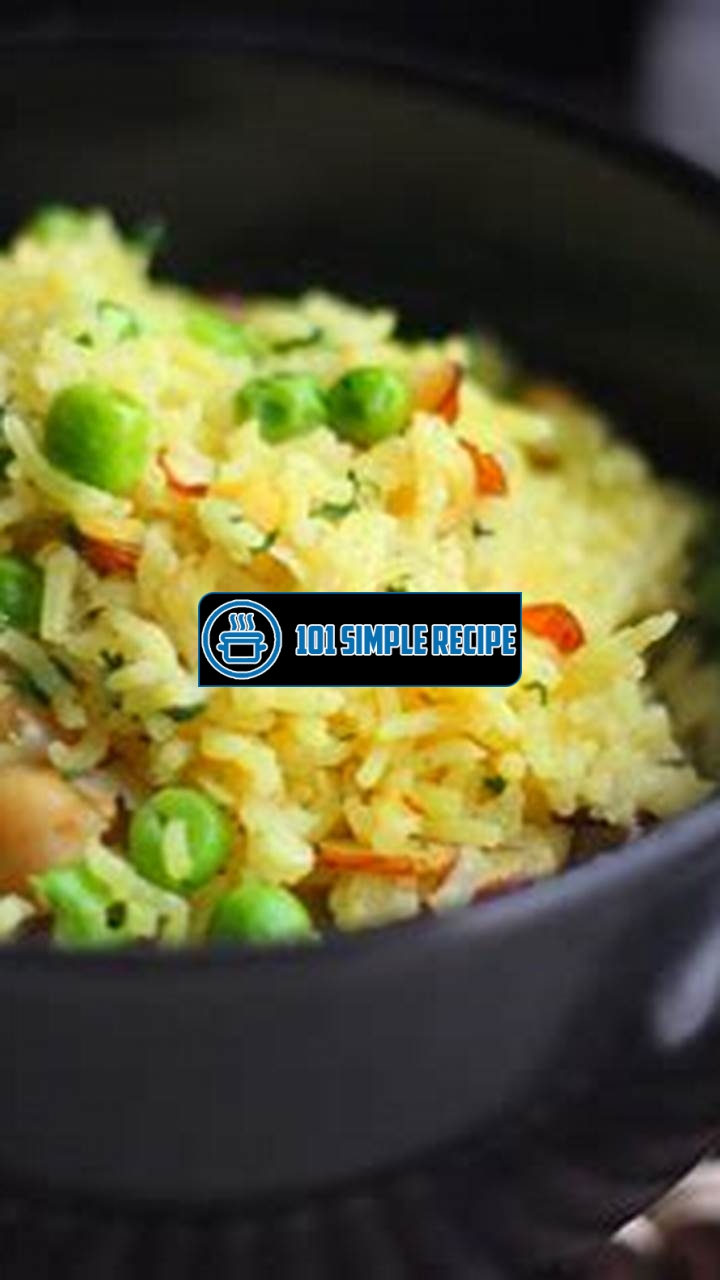Are you craving a delicious and aromatic Indian-style basmati rice dish? Look no further! This recipe will transport you to the bustling streets of India with its fragrant spices and mouthwatering flavors. Whether you’re a seasoned chef or just starting out in the kitchen, this step-by-step guide will help you create a dish that will impress your taste buds and your guests. So, grab your apron and let’s get cooking! ️

What is Indian-Style Basmati Rice?
Indian-style basmati rice is a fragrant long-grain variety highly valued for its unique flavor and aroma. It originated in the Indian subcontinent and has become popular worldwide for its culinary versatility. The name “basmati” comes from the Hindi words “bas” meaning “aroma” and “mati” meaning “full of,” reflecting the rice’s strong fragrance. This variety has a slender, elongated grain that remains separate and fluffy when cooked.
The History of Basmati Rice in India
The history of basmati rice in India dates back thousands of years. It is believed to have originated in the foothills of the Himalayas, where the climate and soil conditions provide the perfect environment for its cultivation. The first recorded mention of basmati rice can be found in ancient Sanskrit texts, which describe it as a delicacy fit for kings and nobles.
Throughout history, basmati rice has played a significant role in Indian cuisine. It was highly regarded for its premium quality and was often used in special occasions and festive meals. The geographical indication status was granted to basmati rice by the Indian government in 2008 to protect its authenticity and ensure that only rice grown in specific regions adheres to the strict quality standards set forth.
Characteristics of Basmati Rice
Basmati rice is known for its distinct characteristics that set it apart from other varieties. One key feature of basmati is its aroma, which is often described as nutty or popcorn-like. When cooked, the grains stay long and slender, with a delicate texture that is light and fluffy. These qualities make basmati rice a preferred choice for various Indian dishes, including biryanis, pilafs, and pulao.
In addition to its aromatic properties, basmati rice is also appreciated for its taste. It has a subtle, slightly sweet flavor that complements a wide range of spices and ingredients. The grains have a natural sweetness and a delicate earthy undertone, making them a perfect accompaniment to flavorful curries and stews.
Another notable characteristic of basmati rice is its ability to absorb flavors. It acts as a canvas for spices and seasonings, allowing them to infuse the grains and enhance the overall taste of the dish. This quality makes basmati rice an excellent choice for creating diverse and flavorful meals.
Varieties of Indian Basmati Rice
Indian basmati rice comes in several varieties, each offering its own unique characteristics. The most popular ones include:
1. Traditional Basmati: This is the classic variety of basmati rice, known for its long and slender grains. It has a rich aroma and a delicate nutty taste. Traditional basmati rice is often aged for a certain period to enhance its flavor.
2. Pusa Basmati: Pusa basmati is a newer variety developed through agricultural research. It shares many of the traits of traditional basmati rice but generally has a shorter grain length. It is favored for its affordability without compromising on quality.
3. 1121 Basmati: 1121 basmati is another popular variety known for its long and slender grains. It is often preferred for its exceptional elongation post-cooking and its ability to retain a pleasant fragrance.
4. Super Basmati: Super basmati is a premium variety of basmati rice known for its extra-long grains and subtle aroma. It is typically aged to further enhance its flavor and quality, making it a sought-after choice for festive occasions.
5. Organic Basmati: Organic basmati rice is cultivated using organic farming practices without the use of synthetic fertilizers or pesticides. It offers the same fragrant and flavorful characteristics as traditional basmati rice but is grown in an environmentally sustainable manner.
Note: It’s important to rinse basmati rice thoroughly before cooking to remove any excess starch and ensure the grains remain separate and fluffy.
Overall, Indian-style basmati rice is a beloved staple in Indian cuisine, cherished for its aromatic properties, distinct taste, and long-grain structure. It continues to be a favorite choice for both everyday meals and special occasions, adding a touch of elegance to any dish it accompanies.
Looking to explore more Indian flavors? Try this palak paneer recipe, a popular Indian dish made with spinach and paneer cheese.
Key Benefits and Nutritional Value
Incorporating Indian-style basmati rice into your diet can offer a range of health benefits and provide essential nutrients. This aromatic rice variety is known for its distinct flavor, long grains, and fluffy texture, making it a popular choice in Indian cuisine. Let’s explore the nutritional profile of basmati rice, its health benefits, and its significance in Indian cooking.
Nutritional Profile of Basmati Rice
Basmati rice is a rich source of carbohydrates, providing energy for your body’s daily functions. It also contains essential B vitamins, such as thiamine (vitamin B1) and niacin (vitamin B3), which play a crucial role in maintaining overall health and vitality. These vitamins help convert food into energy and support proper brain function.
Additionally, basmati rice is low in fat and cholesterol, making it a heart-healthy food option. It also contains small amounts of minerals like calcium, iron, and potassium, which are essential for maintaining strong bones, carrying oxygen in the blood, and regulating blood pressure.
Furthermore, basmati rice is gluten-free and suitable for individuals with gluten sensitivity or celiac disease. It is an excellent choice for those following a gluten-free diet.
Health Benefits of Basmati Rice
Basmati rice offers several health benefits due to its nutrient content and low fat content. One of the major advantages is its ability to regulate blood sugar levels. Basmati rice has a low glycemic index, meaning it releases glucose into the bloodstream at a slower rate compared to other rice varieties. This helps prevent sudden spikes in blood sugar levels, making it an ideal choice for individuals with diabetes.
Moreover, basmati rice contains dietary fiber, which aids in digestion and promotes bowel regularity. It can help prevent constipation and maintain a healthy digestive system.
Basmati rice is also a good source of antioxidants that help fight off free radicals and reduce the risk of chronic diseases, such as heart disease and certain types of cancer. These antioxidants, along with the B vitamins present in basmati rice, contribute to overall immune system support and a strengthened defense against illnesses.
Basmati Rice in Indian Cuisine
Basmati rice holds a significant place in Indian cuisine and is a staple in many Indian households. It serves as the perfect accompaniment to various dishes, including curries, biryanis, and pilafs. The long grains and fragrant aroma of basmati rice enhance the flavors of other ingredients, making it a versatile and popular choice in Indian cooking.
Indian-style basmati rice recipes often involve cooking the rice with flavorful spices like cumin, turmeric, and cardamom, adding a savory and aromatic touch to the dish. It can be cooked in different ways, such as steaming, boiling, or even biryani-style, offering a range of options to suit various preferences.
In conclusion, incorporating Indian-style basmati rice into your diet not only adds delicious flavor to your meals but also provides essential nutrients and various health benefits. Whether you’re looking for a gluten-free option or seeking to regulate your blood sugar levels, basmati rice makes for a nutritious and tasty choice.
If you’re looking for more tasty recipes, check out this Indian chicken biryani recipe that is sure to impress your taste buds.
Preparing Basmati Rice for Cooking
When it comes to cooking delicious Indian-style Basmati rice, the key lies in the preparation process. Rinsing, soaking, and cooking the rice in the right way is essential to achieve those perfect fluffy grains that make your meal so delectable.
Rinsing Basmati Rice
The first step in preparing Basmati rice is to rinse it thoroughly. This helps to remove any impurities and excess starch that might be present on the surface of the grains. To rinse the rice, follow these steps:
- Rinse under cold water: Place the Basmati rice in a sieve and hold it under cold running water. Gently rub the grains together with your fingers to ensure all dirt or impurities are washed away.
- Repeat the process: Continue rinsing the rice until the water runs clear, indicating that the rice is now clean and ready for soaking.
Note: Rinsing the rice helps in removing any dust particles or debris and gives you clean, flavor-packed grains.
Soaking Basmati Rice
Soaking Basmati rice before cooking is another crucial step in the process. This step ensures that the rice grains absorb enough water, allowing them to cook evenly and achieve that perfect fluffy texture. Here’s how you can soak Basmati rice:
- Measure the rice: Take the desired amount of Basmati rice you want to cook and measure it using a measuring cup.
- Add water: Place the measured rice in a bowl and add enough water to cover it completely. Let it soak for at least 30 minutes to an hour. This soaking time will help soften the grains for even cooking.
Note: Soaking the rice allows it to absorb water, resulting in tender and fluffy grains when cooked.
Cooking Basmati Rice
The final step in preparing Indian-style Basmati rice is the cooking process. Following the right method ensures that the grains are cooked to perfection, neither overcooked nor undercooked. Follow these steps to cook Basmati rice:
- Drain the soaked rice: After the desired soaking time, drain the water from the soaked rice using a sieve or colander.
- Add water and salt: For every cup of soaked rice, add 1.5 cups of fresh water to a pot. Add salt according to your taste preferences.
- Bring to a boil: Place the pot on the stovetop over medium-high heat and bring the water to a boil. Once boiling, reduce the heat to low and cover the pot with a tight-fitting lid.
- Simmer for perfect grains: Allow the rice to simmer for around 15-20 minutes, or until all the water is absorbed and the grains are tender. Avoid removing the lid or stirring the rice during this time, as it may affect the cooking process.
- Let it rest: Once the rice is cooked, turn off the heat and let it rest, covered, for about 5-10 minutes. This resting time allows the rice to settle and become even fluffier.
Note: Cooking Basmati rice on low heat and allowing it to rest after cooking helps in achieving perfectly cooked, fluffy grains.
By following these step-by-step methods of rinsing, soaking, and cooking Basmati rice, you can ensure that each grain is delectably fluffy and adds a delightful touch to any Indian-style meal. Enjoy!
For a delicious Indian style basmati rice recipe, try this recipe that is bursting with flavor and aroma.
Popular Indian-Style Basmati Rice Dishes
Basmati rice is a versatile and delicious ingredient that forms the base of many popular Indian dishes. From biryani to pulao to rice kheer, these dishes showcase the rich flavors and fragrant aromas that make Indian cuisine so beloved.
Biryani: The Royal Rice Dish
Biryani is a regal dish that originated in the royal kitchens of India. It is a flavorful rice preparation that combines basmati rice with meat, vegetables, and a blend of aromatic spices. The result is a dish that is rich in flavor and texture, with each grain of rice infused with the fragrant spices.
There are many variations of biryani, with each region in India having its own unique twist. Some popular types include Hyderabadi biryani, Lucknowi biryani, and Kolkata biryani. Each style showcases the diverse culinary traditions that exist within India.
One key component of biryani is the method of cooking. It is typically prepared using the dum cooking technique, where the rice and meat are cooked together in a sealed pot. This allows the flavors to meld together and results in a dish that is both aromatic and flavorful.
Pulao: Fragrant Rice Pilaf
Pulao is a fragrant and flavorful rice dish that is often served as a main course or side dish in Indian cuisine. It is made by cooking basmati rice with a variety of ingredients, such as vegetables, meat, and spices. The rice is usually cooked in a seasoned broth, which infuses it with flavor.
Unlike biryani, pulao is a lighter dish and does not have as many layers of flavors. However, it still packs a punch with its aromatic spices and perfectly cooked grains of rice. It is a versatile dish that can be customized to suit different tastes and dietary preferences.
Some popular varieties of pulao include vegetable pulao, chicken pulao, and shrimp pulao. Each variation showcases different flavor combinations and ingredients.
One key aspect of making a delicious pulao is ensuring that the rice grains are cooked to perfection. They should be fluffy and separate, without any clumps or stickiness.
Rice Kheer: Indian Rice Pudding
Rice kheer is a sweet and creamy dessert that is often made during festivals and special occasions in India. It is made by cooking basmati rice with milk and sugar, and is flavored with cardamom, saffron, and chopped nuts.
The result is a rich and indulgent dessert that is loved by people of all ages. The rice grains become soft and tender, while the milk thickens to form a creamy texture. The aromatic spices add a touch of warmth and complexity to the dish.
Rice kheer is often garnished with chopped nuts, such as almonds and pistachios, as well as dried fruits like raisins. It can be served warm or chilled, making it a versatile dessert option.
One important tip for making rice kheer is to simmer the ingredients slowly over low heat, allowing the flavors to develop and the rice to fully cook. This ensures that the dessert has a creamy consistency and the rice grains are tender.
In conclusion, these popular Indian-style basmati rice dishes are a true testament to the versatility and deliciousness of basmati rice. Whether you’re enjoying a royal biryani, a fragrant pulao, or a creamy rice kheer, each dish showcases the unique flavors and aromas that make Indian cuisine so special. So, next time you’re in the mood for a flavorful and satisfying meal, try one of these classic dishes and experience the magic of basmati rice!
Tips and Tricks for Perfect Basmati Rice
When it comes to cooking basmati rice, there are a few tips and tricks that can help you achieve perfect results every time. Whether you are a beginner or an experienced cook, these techniques will elevate your basmati rice to a whole new level of deliciousness. So grab your apron and get ready to take your rice cooking skills to the next level!
Measuring the Right Amount of Water
One of the most crucial aspects of cooking basmati rice is getting the water-to-rice ratio right. The general rule of thumb is to use 1.5 cups of water for every cup of rice. However, this can vary depending on the brand and type of rice you use. To be more accurate, it’s always a good idea to follow the instructions on the rice package. Additionally, using a measuring cup specifically designed for rice can help you get precise measurements.
Important Tip: For fluffy and perfectly cooked rice, soak the rice for at least 30 minutes before cooking. This will help the grains expand evenly and result in a better texture.
Seasoning Basmati Rice
Basmati rice is known for its delicate and aromatic flavor. To enhance the taste of your rice, you can add a few seasonings while cooking. Some popular choices include whole spices like cloves, cardamom, cinnamon, or bay leaves. You can also add a pinch of salt and a teaspoon of ghee or butter to give your rice a rich and buttery flavor.
Pro Tip: For an extra burst of flavor, try adding a teaspoon of cumin seeds to your rice. The warm and earthy aroma of cumin will take your basmati rice to a whole new level.
Enhancing the Aroma of Basmati Rice
One of the most distinctive characteristics of basmati rice is its heavenly aroma. To make your rice even more aromatic, you can try a few simple techniques. One popular method is to add a few drops of rose water or kewra water to the cooking water. This will infuse your rice with a delightful floral fragrance that will leave your taste buds dancing with joy. You can also add a handful of fresh herbs like cilantro or mint to add a refreshing and fragrant touch to your rice.
Important Note: Remember to remove the whole spices, such as cloves, cardamom, and cinnamon, before serving your rice. These spices are added to enhance the flavor during the cooking process, but can be unpleasant to bite into.
In conclusion, by following these tips and tricks, you can elevate your basmati rice cooking skills and ensure consistently excellent results. From measuring the right amount of water to seasoning your rice with aromatic spices, each step plays a crucial role in creating a delightful bowl of basmati rice. So go ahead, put on your chef’s hat, and enjoy the deliciousness of Indian-style basmati rice!
Frequently Asked Questions
Here are some common questions about Indian-style Basmati rice recipe:
| No. | Questions | Answers |
|---|---|---|
| 1. | What is Basmati rice and how is it different from regular rice? | Basmati rice is a long-grain rice variety that is known for its fragrance and delicate flavor. It is different from regular rice in terms of taste, texture, and aroma. Basmati rice has a nutty flavor and tends to have longer grains that remain separate when cooked, making it ideal for Indian-style rice dishes. |
| 2. | How do I cook Basmati rice perfectly? | To cook Basmati rice perfectly, rinse the rice well before cooking to remove excess starch. Use a 1:2 ratio of rice to water and soak the rice for about 30 minutes before cooking. Cook the rice on low heat with the lid on for about 15-20 minutes or until the grains are fluffy and cooked through. |
| 3. | Can I add spices to Basmati rice? | Yes, you can add various spices and herbs to Basmati rice to enhance its flavor. Common spices used in Indian-style Basmati rice recipes include cumin, turmeric, cardamom, and cinnamon. You can also add vegetables, such as peas or carrots, for additional flavor and nutritional value. |
| 4. | What are some popular Indian dishes that use Basmati rice? | Basmati rice is a staple in many Indian dishes. Some popular recipes include Biryani, Pulao, and Lemon rice. These dishes often feature a combination of aromatic spices, vegetables, and sometimes meat or seafood. |
| 5. | Where can I buy Basmati rice? | Basmati rice is widely available in grocery stores, supermarkets, and online. Look for it in the rice or international section of your local store. Make sure to choose a reputable brand for the best quality rice. |
| 6. | Can I store cooked Basmati rice? | Yes, you can store cooked Basmati rice in an airtight container in the refrigerator for up to 3-4 days. Make sure to cool the rice completely before storing it. To reheat, you can microwave it or heat it on the stovetop with a little water. |
Thanks for Reading!
We hope you enjoyed learning about the Indian-style Basmati rice recipe. It’s a delightful dish that brings the flavors of India to your table. The fragrant aroma and fluffy texture of Basmati rice make it a perfect accompaniment to a variety of Indian curries and dishes. Give it a try and impress your family and friends with your culinary skills. Remember to visit our website again for more delicious recipes and cooking tips.
Jump to Recipe
Indian Style Basmati Rice Recipe

Learn how to make fragrant and flavorful Indian-style Basmati rice with this easy recipe. Serve it as a side dish to elevate your Indian cuisine.
- 2 cups Basmati rice
- 3 cups water
- 1 tablespoon ghee or vegetable oil
- 1 teaspoon cumin seeds
- 1 cinnamon stick
- 3-4 green cardamom pods
- 1 teaspoon salt
- In a large bowl, rinse the Basmati rice with water until the water runs clear. This removes excess starch and helps to make the rice fluffy.
- Soak the rinsed rice in water for about 30 minutes. This step helps the rice grains to cook evenly and become tender.
- In a large pot or saucepan, heat the ghee or vegetable oil over medium heat. Add the cumin seeds, cinnamon stick, and cardamom pods. Sauté for 1-2 minutes until fragrant.
- Drain the soaked rice and add it to the pot. Stir well to coat the rice grains with the spices and ghee.
- Add water and salt to the pot. Bring it to a boil, then reduce the heat to low and cover the pot with a tight-fitting lid. Cook the rice for 15-20 minutes or until the grains are fluffy and cooked through. Avoid stirring the rice during cooking.
- Once the rice is cooked, remove the pot from heat and let it sit covered for a few minutes. Fluff the rice with a fork before serving. Serve hot as a side dish with your favorite Indian curries or main dishes. Enjoy!






